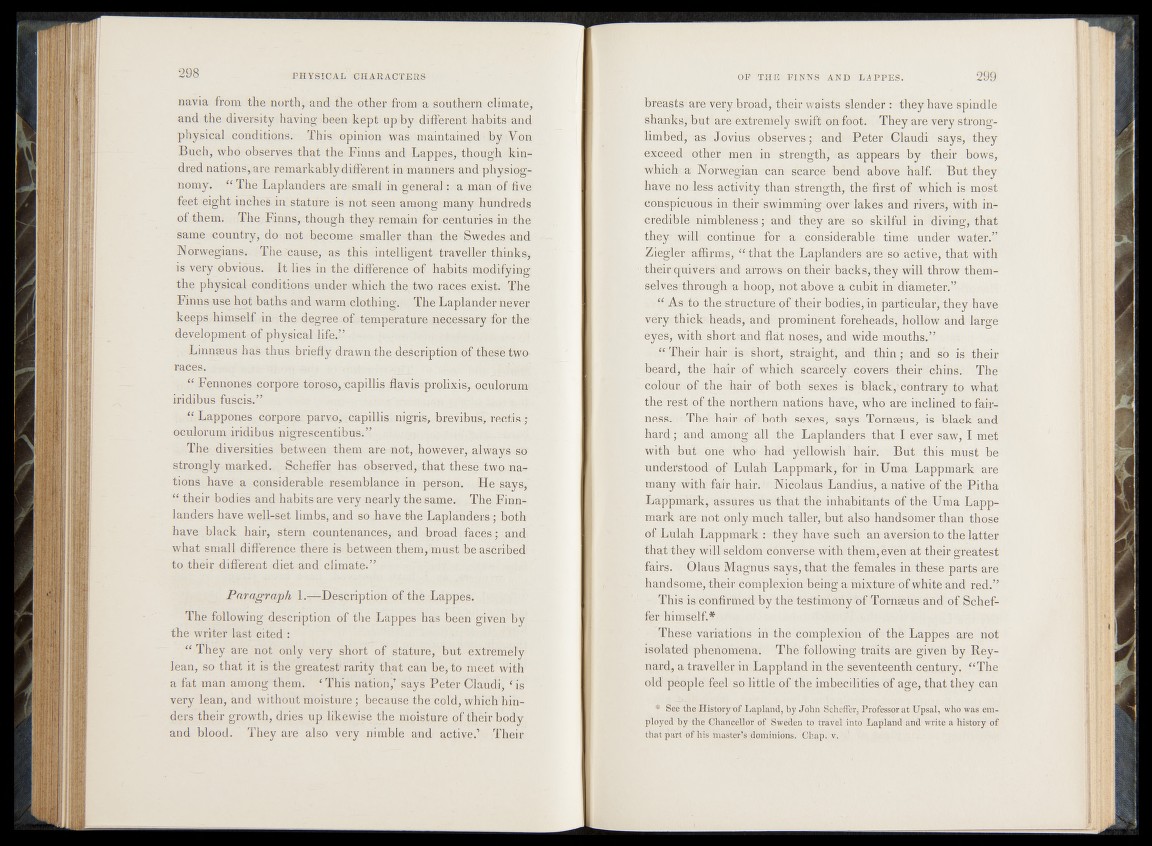
navia from the norths and the other from a southern climate,
and the diveisi-ty : having heed kept'up by different habits and
physical conditions." This;' ©pinion was maintained > by tV*on
m m whoi observes1 that the Finns and Lappes/though, kindred
nations^are remarkably different in manners and physiognomy.
“ The Laplanders are* small in.generals-Fa manof five
feet eight inches imstatiire is-not seen among many hundreds
of them. The, Finns, though they-remain for centufies^i the
same -country, dp not beeome. smaller than the Swedes and
Norwegians* Theteanse^aS; this intelligent traveller ,> ttenk!%
is very obvious. It lies in the difference of habits «modifying
the physical conditions under which the, two races exist; The
F|nn§#^hot baths and warm clothing. «The Laplander never
keeps,himself in the degree ~o£. temperature necessary for the'
development of physical lifell|||
Linnaeus has thus briefly drawn the description of these .two
races. g
• “ Fetmones pprpore tprbsp,jcapillis flavis prolixis, oculorum
iridibus fuscis.”
“ Lappones cprpore parvo, .capillis nigris, brevibus^reGfas .;
OGnlorum iridibus nigrescentibus.”
The diversities , between them are -not, „however.,- always -sP
strongly marked.; ^Scheffer has Observed, that thesp.7twpfna-
tions have a Qpnsiderable. veaemblanceun person. -He say %
“ their bodies and habits are very nearly the same. The Finn-
landers have well-set limbs, and so Jbave the Laplanders ; both
have black hair, stern countenances,-; and broad: faces; and-,
what small difference there is between them, must be ascribed
to their different diet and climate.”
Paragraph 1.—Description of the Lappes.
The following description of the Lappes has been given by’
the writer last cited :
“ They are not only very short of stature, but extremely
lean, so that it is’the greatest rarity that can be, to meet with
a fat man among them. ‘'This nation,7 says Peter Claudi, 1 is
very lean, and without moisture; because the cold, which hinders
their growth, dries up likewise the moisture of their body
and blood. They are also very nimble and active.’ Their
breastsiare very broad, their waists slender : they have spindle
shan'ks, but-Jare* extremely swift ©n foot. They are very strong-
limbed,‘ -as -Jovius observes; and Peter Claudi says, they
exceed 'other men in strength, as appears by their. bows,
which;,» Norwegian cab scarce: bend above half. • But they
havdinoiiess activity/ than strength, the first of which is most
conspicuous imtkeir swimmmg/ó'ver lakes and rivers, with incredible
nimbleness ;iand' they are s$h skilful in 'diving, that
they?? will continue«;€or a considerable, time-, under -water.ft
Zl^fetf-affirni-^“ thatddie4LapIanders<'aissy;sd' active,'that with
their;quivefs: and arrows on their back’s/they will throw them-
felvesrthrough a hoopy‘;ndt above a cubit in diameter.”
*;5-?>*A.8'.to the structure of their‘bodies, in parti ctdarj they have
ve!r.y thick heads, and prominent Tör©heads;! hollów and large
eyes; with sboirtrand flat noses, and wide mouths.”
"Their, hair is short, straight, and thin; and so is their
beard, the 'hafrfof which scarcely..covers'their chins. The
Golcrur; of the hair ofboth?sekfes&-is black/ contrary. to what
the restvof• the northern nations ha'Ve, who-are inclined to fairness:
» > The- hair-r'.éfj-both: sexes, says Tornseus, is black and
hard; and 'among- all the Laplanders that I ever saw, I met
with» but one' who had'-yellowish'hair. But this must be
understood of Lulah Lappniark, for in Uma Lapp mark are
many with fan?diair. Nicolaus Laridius, a.nativè of the Pitha
Lapjpmark, assures us that the inhabitants of thertUma Lapp-
markare not only mnch taller, but also handsomer than those
of Lulah Lappmark : -they have such an aversion to the latter
that they will seldom converse with them, èvén at them greatest
fairs. Olaus Magnus says, that the females in these parts are
handsome, their complexion being a mixture of white and red.”
- This is confirmed by the testimonybf Tomseus and of Sjlllbf-
fer himself.*
These variations in the complexion of the Lappes are not
isolated phenomena. The following traits are given by Reynard,
a traveller in Lappland in the seventeenth century, “ The
old people feel so little of the imbecilities of age, that they can
* See the Historyx»f Lapland, by John Scheffer, Professor at Upsal, who was employed
by the Chancellor of Sweden to travel into Lapland and Write a history of
that part of his master’s dominions. Chap; v. .'